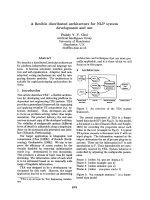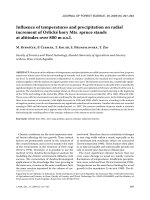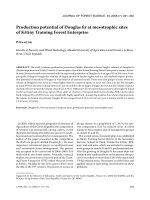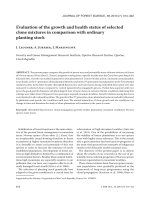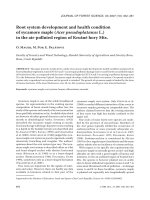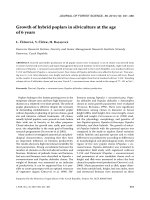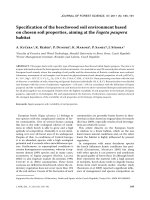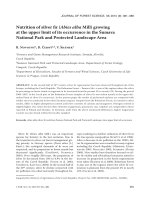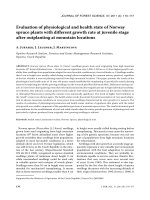Báo cáo lâm nghiệp: "Fertilization at planting impairs root system development and drought avoidance of Douglas-fir (Pseudotsuga menziesii) seedlings" pot
Bạn đang xem bản rút gọn của tài liệu. Xem và tải ngay bản đầy đủ của tài liệu tại đây (289.86 KB, 9 trang )
643
Ann. For. Sci. 61 (2004) 643–651
© INRA, EDP Sciences, 2004
DOI: 10.1051/forest:2004065
Original article
Fertilization at planting impairs root system development and drought
avoidance of Douglas-fir (Pseudotsuga menziesii) seedlings
Douglass F. JACOBS
a,b
*, Robin ROSE
a
, Diane L. HAASE
a
, Patricio O. ALZUGARAY
a,c
a
Department of Forest Science, Oregon State University, Corvallis, OR, 97331-5752, USA
b
Current address: Hardwood Tree Improvement and Regeneration Center (HTIRC), Department of Forestry and Natural Resources,
Purdue University, West Lafayette, IN, 47907-2061, USA
c
Current address: Chilean Forestry Institute INFOR, camino a Coronel Km 7.5, Concepción, Chile
(Received 18 July 2003; accepted 12 January 2004)
Abstract – Douglas-fir (Pseudotsuga menziesii (Mirb.) Franco) seedlings (1 + 1 bareroot) were divided into 8–13 cm
3
and 23–35 cm
3
initial
root-volume categories and either not fertilized or fertilized with 60 g Apex
®
in the planting hole at a drought-prone clearcut site in the Oregon
Coast Range, USA. Regardless of initial root volume, fertilized seedlings consistently reached lower predawn xylem water potential (Ψ
xylem
)
values than non-fertilized seedlings during summer. Roots did not proliferate relative to fertilizer placement and mean values for lateral-root
length, root tips, and root biomass were less for fertilized seedlings in each of four vertical root zones. Poor root system development of
fertilized seedlings may have been associated with the rapid release of high fertilizer salt concentrations into the rhizosphere. Root-volume
growth was positively correlated with Ψ
xylem
, emphasizing the importance of new root growth following planting for drought avoidance.
Criteria for successful field fertilization must consider the anticipated drought level of the site.
seedling / controlled-release fertilizer / root architecture / drought avoidance / Pseudotsuga menziesii
Résumé – La fertilisation à la plantation perturbe le développement du système radiculaire et réduit la résistance à la sécheresse des
plants de Douglas (Pseudotsuga menziesii). On a utilisé deux catégories de plants à racines nues (1 + 1) de Douglas (Pseudotsuga menziesii
(Mirb.) Franco) dont le volume initial des racines était respectivement de 8 à 13 cm
3
et de 23 à 35 cm
3
. Ces plants furent installés dans une
station de clairière plutôt sèche, située dans la Chaîne côtière de l’Oregon aux USA, et soumis à deux traitements : pas de fertilisation ou
fertilisation avec 60 g d’Apex
®
introduits dans le trou de plantation. Quelque soit le volume racinaire initial, les plants fertilisés révèlent, au
cours de l’été, des valeurs de potentiel hydrique du xylème en fin de nuit (Ψ
xylem
) toujours inférieures à celles obtenues sur plants non fertilisés.
Les racines ne se sont pas développées dans les zones en contact avec l’engrais, et les valeurs moyennes de longueur de racines latérales, de
nombre de pointes racinaires, et de biomasse racinaire sont inférieures pour les plants fertilisés, dans les quatre plans verticaux. Ce mauvais
développement du système racinaire des plants fertilisés peut être associé à la libération rapide d’engrais à forte concentration minérale dans la
rhizosphère. La croissance racinaire en volume était corrélée positivement avec le Ψ
xylem
ce qui permet de souligner l’importance de la
croissance des racines après plantation pour limiter les effets de la sécheresse. Les critères à adopter pour réussir une opération de fertilisation
de terrain doivent donc prendre en considération l’éventuel degré de sécheresse de la station.
plant / engrais à libération contrôlée / architecture racinaire / limitation des effets de sécheresse / Pseudotsuga menziesii
1. INTRODUCTION
The success of reforestation operations may be improved if
seedlings remain on a growth trajectory following outplanting
similar to that in the nursery. Transplant shock often limits the
ability of bareroot seedlings to grow vigorously the first one to
two years following planting [50]. Fertilization at planting
offers a potential means to reduce transplant shock and accel-
erate initial plantation growth [2, 14]. Interest in using control-
led-release fertilizer (CRF) at planting has increased over the
past decade [26] due to advantages in fertilizer-use efficiency
that this fertilizer type offers over conventional fertilizer forms
[28]. With a single application, CRF gradually supplies planted
seedlings with supplemental nutrition for several months. The
ideal CRF product delivers nutrients at a rate matching plant
demand, thus improving crop yield and minimizing nutrient
loss due to leaching [24, 29].
Reports of seedling growth response to CRF at outplanting
vary considerably [8] and one possible reason may be method
of CRF application. Fertilizer may be applied to the planting
hole, to an adjacent hole, or surface broadcast [8]. To facilitate
nutrient uptake, many researchers have recommended applying
CRF directly in the planting hole, such that nutrients are
released in the immediate vicinity of the root system [2, 12, 14,
23, 52]. However, fertilization in the planting hole may limit
root system expansion because roots tend to proliferate in areas
* Corresponding author:
644 D.F. Jacobs et al.
of high nutrient supply, as observed in numerous controlled
experiments [16, 19, 21]. The diffusion of fertilizer salts into
the soil solution may also restrict root penetration into subsoil
zones, as excessive fertilizer salts kill root apical meristems due
to the buildup of toxic ion concentrations and osmotic effects
[18, 33].
Restrictions to root growth may reduce the ability of seed-
lings to maintain adequate xylem water potential, termed
drought avoidance [59], during the critical establishment
period following outplanting. Shoot growth following planting
is generally most limited by water availability [10]. When bare-
root seedlings are lifted from the nursery, a significant portion
of roots, particularly fine roots, are lost [43]. Although there is
evidence that planting seedlings with large root volumes may
reduce moisture stress and subsequent transplant shock [13,
25], survival of newly-planted seedlings is largely dependent
on the rapid extension of roots, which reestablish root-soil con-
tact and thereby absorb water to reduce stress from transpira-
tional loss [51, 54]. Without efficient water extraction, seedlings
continue to transpire, resulting in a condition of physiological
drought which contributes to transplant shock and limits whole-
plant growth [50].
Following planting, seedlings usually increase root growth
relative to shoot growth [37]. A decreased shoot:root ratio
allows a greater soil volume to be exploited with relatively less
transpirational demand from the shoot [32, 40]. Fertilization at
outplanting when soils are wet, however, may act to increase
shoot:root ratios relative to non-fertilized seedlings, as high
nutrient availability and sufficient water can limit the need for
root expansion [31, 32, 57]. Reduced root expansion relative
to shoot growth associated with field fertilization could further
increase water stress after soils dry [22].
Few field experiments have studied seedling root prolifera-
tion in response to localized nutrient sources. Additionally, little
information is available concerning the ability of field-fertilized
seedlings to avoid drought immediately following planting.
This experiment was designed to examine the influence of ini-
tial root volume and field fertilization at a relatively high applica-
tion rate on seedling root architectural development and
drought avoidance. A sub-sample of seedlings in four treat-
ments from a larger experiment [1] was used. We hypothesized
that relative to a non-fertilized control, field fertilization would
result in (i) greater allocation of biomass to shoot relative to root
tissues, (ii) localized root proliferation at the point of CRF
placement and decreased subsoil penetration, and (iii) reduc-
tions in xylem water potential and stomatal conductance, which
would be less pronounced for seedlings with a larger initial root
volume.
2. MATERIALS AND METHODS
2.1. Plant material
Douglas-fir (Pseudotsuga menziesii (Mirb.) Franco) seedlings
(Seed Zone 262; Western Forest Tree Seed Council, State of Oregon
Tree Seed Zones) were grown for 2 yr (1 + 1 bareroot) using standard
nursery practices at Weyerhaeuser’s Aurora, OR, USA nursery until
lifting in December 1999. Following lifting, seedlings were graded to
operational specifications and placed in cold storage at 3 °C. Several
days before outplanting, seedlings were washed free of soil and meas-
ured for root volume by water displacement [9]. Each seedling was then
numbered, tagged, and returned to cold storage. Seedlings were
divided into categories based on initial root volume. For this study,
seedlings examined were from initial root-volume categories of 8–
13 cm
3
(11.2 ± 0.2) (mean ± SE) (RVC1) and 23–35 cm
3
(27.0 ± 0.4)
(RVC2).
2.2. Fertilizer treatments
Seedlings were either non-fertilized or fertilized with 60 g of a
blended CRF (Apex
®
, J.R. Simplot Co., Boise, ID, USA) containing
equal amounts of three fertilizers with differing release rates (manu-
facturer’s estimates at 21 °C media temperature) (Tab. I). By using a
CRF with a mixture of release rates, a more steady supply of nutrients
through the desired release period may potentially be achieved. The
60-g rate was the highest rate used in the larger study [1] and we chose
to closely examine seedling development at this rate relative to con-
trols based on previous trials showing negative growth results from
similar rates applied at planting on sites subject to dry summers [45].
This CRF consists of prills containing water-soluble nutrients encap-
sulated within a polyurethane coating, which acts to slow nutrient dis-
solution. Nutrient release from polymer-coated CRF is primarily con-
trolled by soil temperature and a more rapid rate of release occurs with
increasing temperature [34]. Fertilizer was applied to the bottom of the
approximately 25-cm planting hole, covered by 1–2 cm of soil, and the
seedling was planted with lateral roots generally extending to within
2 cm of the fertilizer layer.
Soon after planting, a companion study was installed adjacent to
this study to quantify the release of nutrient ions from this CRF [27].
Fertilizer nutrients released relatively rapidly, with 9, 22, 34, and 48%
of the composite fertilizer releasing by weight during the first 13, 20,
27, and 35 weeks, respectively. Specifically, 26, 33, 55, and 65% of
total N, 6, 15, 15, and 24% of P
2
O
5
, and 9, 16, 34, and 51% of K
2
O
released from the fertilizer during the first 13, 20, 27, and 35 weeks,
respectively. During the approximately 48-week period of the present
study, 55% of the fertilizer released by weight and 73% of total N, 26%
of P
2
O
5
, and of 63% of K
2
O released. This was 87–92% of the total
released for all variables during a 62-week sampling period.
Table I. Nutrient composition of the three Apex
controlled-release
fertilizer (CRF) types blended to create the composite fertilizer used
in the experiment. Estimated manufacturer timeframe for nutrient
release at 21 °C media temperature is listed for each CRF type.
Nutrient
CRF 1
(3–4 month)
CRF 2
(5–6 month)
CRF 3
(8–9 month)
CRF
composite
Composition (%)
N (NH
4
) 8.2 8.2 7.7 8.1
N (NO
3
) 10.8 10.8 10.3 10.6
P (P
2
O
5
) 5.0 6.0 6.0 5.7
K (K
2
O) 12.0 12.0 12.0 12.0
Mg 1.0 0.9 0.9 0.9
S 1.8 1.7 1.7 1.7
Fe 0.5 0.5 0.5 0.5
Mn 0.2 0.2 0.2 0.2
Mo 0.01 0.01 0.01 0.01
Zn 0.06 0.06 0.05 0.05
Fertilization effects on root growth and drought 645
2.3. Field site
The outplanting site was in Oregon State University’s Dunn Exper-
imental Research Forest (44° 43’ N, 123° 20’ W). This site is on the
eastern edge of the Oregon Coast Range, an area characterized by mild
winters with heavy precipitation and hot, dry summers. The 38-ha site
was clearcut in 1998 and slash was piled and burned shortly thereafter.
The aspect of the site was predominantly east, elevation averaged
317 m, slopes ranged from 5–10%, and the soil was a deep, well-drained
silty-clay loam (Waldo series). Seedlings were planted on 19 January
2000 at a 3 m × 3 m spacing. Immediately following planting, Vexar
®
tubing was installed to protect seedlings from animal damage.
Pre-plant (30 August 1999) vegetation was controlled on the site using
metsulfuron (Escort
®
, 0.05 kg/ha), sulfometuron (Oust
®
, 0.21 kg/ha),
glyphosate (Accord
®
, 4.67 L/ha), and imazapyr (Arsenal
®
, 0.44 L/ha).
Subsequent control included hexazinone (Velpar
®
, 28 March 2000,
7.00 L/ha) and clopyralid (Transline
®
, 9 June 2000, 0.73 L/ha). The
objective was to attain maximum vegetation control to minimize var-
iation in soil water potential across the site.
2.4. Measurements
Seedlings were sampled for predawn xylem water potential (Ψ
xylem
)
on four dates during 2000 (3 July, 31 July, 31 August, and 27 Septem-
ber). Four (3 July) or five (all other dates) seedlings from each treat-
ment replication were sampled. A lateral branch from the lower half
of the terminal shoot was cut from each seedling and within 5 min, a
measurement of Ψ
xylem
using a Scholander-type pressure chamber
(Model 600, PMS Instruments, Inc., Corvallis, OR, USA) as per meth-
odology in [15] was recorded.
Morning and afternoon stomatal conductance (g
s
) was sampled
using a porometer (Model LI-1600, Li-Cor, Inc., Lincoln, NE, USA) on
five seedlings from each treatment replication on 28 and 29 September
2000. Two blocks were sampled on the first day and the remaining two
blocks on the second day. The weather was clear each day. The same
lateral branch on the lower half of the terminal shoot was sampled for
both morning (0800–1000 h, solar time) and afternoon (1300–1500 h,
solar time) g
s
. The sampled foliage was then excised and placed into
cold storage at 3 °C. Leaf area of each foliage sample was assessed
using a Panasonic
®
video image recorder (Model WV-CD20, Matsu-
shita Communication Industrial Co., Ltd., Yokohama, Japan) and AgVi-
sion software (Decagon Devices, Inc., Pullman, WA, USA) to adjust
gas exchange measurements for variation in leaf area.
On 8 December 2000, each seedling used for sampling of Ψ
xylem
and g
s
was excavated from the soil with care to preserve the root system
and placed into cold storage at 3 °C. Within 7 d, seedlings were meas-
ured for height from cotyledon scar to base of terminal bud, root-collar
diameter, taproot length, shoot and root volume, and shoot dry weight.
Root architectural development was assessed based on the vertical
distribution of roots within the soil profile. Because seedlings were
sampled soon after excavation, were dormant when excavated, and had
relatively well-lignified root structures, we assumed that roots held
approximately the same vertical architectural orientation that was
present in the soil. Seedlings were clipped at cotyledon scar and again
5 cm below this point, which was the minimum distance from cotyle-
don scar where lateral roots initiated. The remaining roots were then
sliced into four 7.5-cm vertical sections (S1-S4), with roots infre-
quently extending into the deepest section (S4). The fertilizer was
placed at a depth of approximately 25 cm in the soil and therefore gen-
erally associated with S3. Roots in each section were divided into tap
and lateral roots, with the taproot never extending beyond S2. Within
each root section, the number of root tips (white tips > 1 mm in length)
and first-order lateral-root length were assessed. Root sections were
then dried at 70 °C for 72 h and dry weights of tap and lateral roots
were recorded for each vertical root section.
2.5. Experimental design and statistical analysis
The experiment was arranged as a randomized complete block
design with four blocks and factorial treatments (two initial root-vol-
ume categories × two fertilization rates). Five seedlings were sampled
from each treatment within a block (with exception of 3 July Ψ
xylem
),
for a total of 80 seedlings in the experiment. The experimental unit
was the group of seedlings within a treatment replication and the sam-
pling unit was the individual seedling.
Data were subjected to analysis of variance (ANOVA) for a rand-
omized complete block design with factorial treatments. Tests for nor-
mality and constant variance were performed to ensure the validity of
the assumptions of ANOVA and no transformations were necessary.
Only in the absence of a significant (P < 0.05 in F test) root volume ×
fertilization rate interaction were the main effects (root volume and
fertilization) analyzed to determine if significant differences were
present. Fisher’s Protected Least Significant Difference procedure
was used to identify significant differences (α = 0.05) among treat-
ments. Regression analyses were used to determine the relationship
between root-volume growth and Ψ
xylem
or g
s
. Orthogonal contrasts
were used to determine the statistical significance of higher-order
regression models but only linear relationships were significant. The
mean values of each of the four replicates for each treatment were used
in the regression and an adjusted R
2
value was determined to indicate
the fit of the model. SAS
®
software (SAS Institute Inc., Cary, NC,
USA) was used for analysis of all data.
3. RESULTS
3.1. Xylem water potential and stomatal conductance
Water stress of seedlings in all treatments increased through
time during summer (Fig. 1). However, the Ψ
xylem
of fertilized
seedlings was lower (i.e., more drought stressed) than non-fer-
tilized seedlings on 3 July (P = 0.0113), 31 July (P = 0.0020),
and 31 August (P = 0.0006) (Fig. 1). From 15 June through
Figure 1. Predawn xylem water potential of fertilized and non-ferti-
lized seedlings (averaged across root-volume categories) at four sam-
pling points. Data points are means, and error bars are SEs. At each
sampling point, * P < 0.05, ** P < 0.01, and *** P < 0.001.
646 D.F. Jacobs et al.
1 September, only 0.46 cm precipitation was recorded in Cor-
vallis, OR, approximately 20 km south of the study site [47].
In early September, 1.63 cm of precipitation was recorded in
Corvallis, OR. Mean Ψ
xylem
on 27 September increased for all
treatments, particularly for fertilized seedlings. There was no
significant difference in Ψ
xylem
at any sampling between root-
volume categories (data not shown). There was also no signif-
icant root volume × fertilization rate interaction for Ψ
xylem
at
any sampling point, indicating that effects of fertilization on
Ψ
xylem
were not dependent on initial root volume.
Values of g
s
were higher for non-fertilized seedlings than
fertilized seedlings during both morning (P = 0.0052) and after-
noon (P = 0.0126) samplings (Fig. 2). There was no significant
difference in g
s
between root-volume categories during the
morning or afternoon (data not shown).
3.2. Whole plant morphology
Following seedling excavation in December 2000, root-collar
diameter of non-fertilized seedlings was greater than that of fer-
tilized seedlings (P = 0.0270) (Tab. II). Shoot:root volume (P =
0.0243) and shoot:root dry weight (P = 0.0100) were greater
for fertilized than for non-fertilized seedlings. Mean height
(P = 0.4245), shoot volume (P = 0.0516), and shoot dry weight
(P = 0.0991) did not differ between fertilizer treatments.
Height, diameter, and shoot volume were greater (P < 0.0001)
for RVC2 than RVC1 (Tab. II). Shoot:root volume was also
greater for seedlings in RVC2 than in RVC1 (P = 0.0421),
though shoot:root dry weight was not (P = 0.6610).
Initial root volume was greater for RVC2 seedlings than
RVC1 seedlings (P < 0.0001) (Fig. 3). At excavation, means
Table II. Mean values ± SE for seedling morphology of fertilizer treatments (averaged across root-volume categories) and root-volume cate-
gories (averaged across fertilization treatments) following excavation in December 2000. For each parameter for either fertilizer treatment or
root-volume category, means followed by the same letter in a row did not differ significantly (P < 0.05).
Fertilizer treatment Root-volume category
Non-fertilized Fertilized 8–13 cm
3
23–35 cm
3
Height (cm) 36.0 ± 1.8 a 37.1 ± 2.3 a 31.5 ± 0.7 b 42.0 ± 1.2 a
Diameter (mm) 8.3 ± 0.5 a 7.8 ± 0.4 b 7.0 ± 0.3 b 9.1 ± 0.2 a
Taproot length (cm) 13.6 ± 0.6 a 12.6 ± 0.3 a 12.9 ± 0.5 a 13.3 ± 0.4 a
Shoot volume (cm
3
) 35.3 ± 6.3 a 29.6 ± 4.2 a 19.6 ± 2.3 b 45.3 ± 3.3 a
Root volume (cm
3
)
1
27.1 ± 4.3 18.5 ± 2.4 15.8 ± 2.2 29.9 ± 3.5
Shoot:root volume 1.3 ± 0.1 b 1.6 ± 0.1 a 1.3 ± 0.1 b 1.6 ± 0.1 a
Shoot dry weight (g) 12.4 ± 2.0 a 11.0 ± 1.6 a 7.4 ± 0.8 b 16.0 ± 1.1 a
Root dry weight (g)
1
9.0 ± 1.4 6.1 ± 0.8 5.0 ± 0.7 10.1 ± 1.1
Shoot:root dry weight 1.4 ± 0.1 b 1.9 ± 0.1 a 1.6 ± 0.1 a 1.7 ± 0.1 a
1
A significant root volume × fertilization rate interaction occurred.
Figure 2. Stomatal conductance for fertilized and non-fertilized see-
dlings (averaged across root-volume categories) sampled during mor-
ning and afternoon hours on 28 and 29 September 2000. Data points
are means, and error bars are SEs. At each sampling point, * P < 0.05
and ** P < 0.01.
Figure 3. Initial seedling root volume at time of planting (January
2000) and following excavation (December 2000). Bars are means,
and error bars are SEs. At each sampling point, treatments with the
same letter did not differ significantly (α = 0.05).
Fertilization effects on root growth and drought 647
for both root volume and root dry weight were greater for non-
fertilized than fertilized seedlings (Tab. II). However, there was
a significant root volume × fertilization rate interaction for
these parameters (P = 0.0429 and 0.0250, respectively). Mean
root volume was greatest for the non-fertilized RVC2 treatment
(Fig. 3). Interestingly, mean root volume of the fertilized RVC2
treatment did not differ from the non-fertilized RVC1 treat-
ment, despite significant differences at the onset of the study.
Treatment differences were similar for root dry weight at exca-
vation, except that mean root dry weight of fertilized RVC2
seedlings was significantly greater than that of non-fertilized
RVC1 seedlings (data not shown).
Pre-dawn Ψ
xylem
increased linearly with root-volume
growth on 3 July (P = 0.0016, R
2
= 0.49) (Fig. 4), 31 July (P =
0.0034, R
2
= 0.43), and 31 August (P = 0.0195, R
2
= 0.28).
Differences in the grouping of data points for non-fertilized and
fertilized seedlings reflected the lower root-volume growth and
Ψ
xylem
for fertilized seedlings (Fig. 4). Both morning (P =
0.0258, R
2
= 0.26) and afternoon (P = 0.0149, R
2
= 0.31) g
s
also
increased linearly with root-volume growth.
3.3. Root architecture
The mean number of root tips tended to be greater for non-
fertilized than fertilized seedlings in all root zones (Tab. III).
Differences were significant in the S1 (P = 0.0313) and S3 (P =
0.0497) root zones, though not in S2 (P = 0.1113) or S4 (P =
0.1948). The total number of root tips was also greater for non-
fertilized than fertilized seedlings (P = 0.0327) (Tab. III).
Mean total first-order lateral-root length was greater (P =
0.0185) (Tab. III) for non-fertilized than fertilized seedlings.
Taproot length did not differ between fertilizer treatments (P =
0.1473) (Tab. II). Total taproot dry weight, which included the
2.5-cm segment excluded from the root-zone analysis, was
greater for non-fertilized than fertilized seedlings (P = 0.0017),
as was taproot dry weight in S1 (P = 0.0061) and S2 (P =
0.0296) (Tab. III). Means for lateral-root dry weight tended to
be greater for non-fertilized than fertilized seedlings in all root
zones, though not statistically significant in S3 (P = 0.0679) or
S4 (P = 0.1207) (Tab. III). A root volume × fertilization rate
interaction was detected for lateral-root dry weight in S1 (P =
0.0168), S2 (P = 0.0296), and for total lateral-root dry weight
Table III. Mean values ± SE for root architecture parameters of fertilized and non-fertilized seedlings (averaged across root-volume catego-
ries) following excavation in December 2000. Root systems were divided into 7.5-cm vertical soil segments (S1–S4), beginning 5 cm below
cotyledon scar, with roots infrequently extending into the deepest section (S4). For each parameter, means followed by the same letter in a row
did not differ significantly (P < 0.05).
Fertilizer treatment
Non-fertilized Fertilized
S1 number of root tips 137 ± 16 a 101 ± 11 b
S2 number of root tips 126 ± 15 a 94 ± 17 a
S3 number of root tips 54 ± 10 a 30 ± 7 b
S4 number of root tips 11 ± 4 a 4 ± 2 a
Total number of root tips 328 ± 40 a 229 ± 34 b
S1 lateral-root length (cm) 94 ± 7 a 88 ± 8 a
S2 lateral-root length (cm) 95 ± 10 a 83 ± 10 a
S3 lateral-root length (cm) 36 ± 7 a 23 ± 4 a
S4 lateral-root length (cm) 11 ± 4 a 3 ± 2 a
Total root length (cm) 236 ± 24 a 197 ± 21 b
S1 taproot dry weight (g) 1.28 ± 0.16 a 0.88 ± 0.11 b
S2 taproot dry weight (g) 0.04 ± 0.012 a 0.01 ± 0.003 b
Total taproot dry weight (g)
1
2.98 ± 0.16 a 2.36 ± 0.10 b
S1 lateral-root dry weight (g)
2
3.15 ± 0.54 2.15 ± 0.30
S2 lateral-root dry weight (g)
2
2.13 ± 0.40 1.28 ± 0.22
S3 lateral-root dry weight (g) 0.64 ± 0.17 a 0.31 ± 0.07 a
S4 lateral-root dry weight (g) 0.11 ± 0.04 a 0.03 ± 0.01 a
Total lateral-root dry weight (g)
2
6.03 ± 1.10 3.76 ± 0.55
1
Includes portion of taproot that was excluded in root zone analysis.
2
A significant root volume × fertilization rate interaction occurred.
648 D.F. Jacobs et al.
(P = 0.0377) (data not shown). Similar to treatment differences
noted for root volume, non-fertilized RVC2 seedlings had the
greatest total lateral-root dry weight, while that of the fertilized
RVC2 and non-fertilized RVC1 did not differ. The mean lat-
eral-root dry weight of non-fertilized RVC1 did not differ from
the fertilized RVC1.
4. DISCUSSION
4.1. Influence of fertilization on root development
Fertilization clearly inhibited root growth in this study
(Tab. III and Fig. 3). This may have been partly associated with
the release of fertilizer nutrients acting to decrease the need for
new root growth to extract soil nutrients. Under conditions of
high nutrient availability and low water stress during spring,
seedlings may allocate more biomass to shoots and less to roots
since below-ground resources are sufficient for growth [39].
Reports of increased seedling shoot:root ratios in response to
fertilization are common [14, 49, 57] and consistent with the
greater shoot:root observed for fertilized seedlings (Tab. II). How-
ever, root elongation was not only reduced for fertilized seedlings
relative to non-fertilized seedlings, but root volume actually
decreased for fertilized RVC2 from time of planting to exca-
vation (mean 26.6 vs. 22.8 cm
3
) (Fig. 3).
Thus, root system development of fertilized seedlings may
have been inhibited by the buildup of excessive fertilizer salts
in the soil solution, as observed in a previous study in which
Douglas-fir seedling roots were unable to penetrate beyond a
localized fertilizer layer [33]. Nutrient release of polymer-
coated CRF is determined by the migration of water vapor
through the fertilizer prill membrane, and this process is largely
dependent on soil temperature [34]. Soil moisture between 50–
100% of field capacity has essentially no influence on release
rate, release is slower at 25% field capacity, and no release
occurs in dry soil [34]. Periodic excavation of fertilizer samples
over time indicated that nutrients continued to release into the
soil solution at a relatively consistent rate during the summer
dry period, and 55% of total N had released within 27 weeks
of application [27]. As fertilizer nutrients are released, the elec-
trical conductivity (EC) of the soil solution increases and solute
potential decreases. Without adequate water to leach nutrients
from the soil, concentrations of fertilizer salts likely increased
in the soil solution, leading to root dehydration and limiting water
uptake. Though magnified under dry soil conditions, this type
of physiological drought associated with high solute concentra-
tions can occur even when soil moisture is at field capacity [35].
Conifers, and Douglas-fir in particular, are sensitive to high
EC levels [36]. Tolerance to high salt concentrations varies
with size of root stock and generally increases with age [61].
Thus, young Douglas-fir seedling roots may be highly vulner-
able to injury associated with excessive fertilization, which
may help to explain the poor root development of seedlings fer-
tilized at a relatively high rate in this study.
We expected increased root proliferation at or above the
position of CRF placement and greater root damage in the lower
root sections compared to the upper root sections, as observed
in a greenhouse experiment with Douglas-fir seedlings grown
in containers [33]. However, there was no distinct proliferation
of roots at the approximate position of CRF (vertical root zone
S3) or any other root zone, and mean values for root parameters
tended to be lower in all root zones for fertilized compared to
non-fertilized seedlings (Tab. III). There are several possible
explanations for this result. White root tips are anatomically
suited for efficient ion uptake [48] and tend to increase in nutrient-
rich solutions [17]. The lack of increased numbers of root tips,
root length, or root biomass in any root zone for fertilized seed-
lings suggests that nutrient toxicities throughout the rhizosphere
associated with rapid nutrient release from this high fertilizer
application may have inhibited root proliferation in all zones.
Additionally, the greater drought stress incurred by fertilized
as compared to non-fertilized seedlings may have reduced whole-
plant physiological vigor, further limiting root system develop-
ment in all root zones. It is also possible that the inherent variation
in studying root proliferation relative to fertilizer placement in
the field (i.e., precision of planting hole size, fertilizer depth,
seedling placement, etc.) and the division of root systems fol-
lowing whole-plant removal from the soil (as compared to sep-
aration with soil core intact) limited our ability to detect localized
changes in root proliferation.
Seedling root development in the largest root-volume cate-
gory (RVC2) was more negatively affected by fertilization than
in the smallest root-volume category (RVC1) (Fig. 3). This may
have been due to increased root-fertilizer contact for seedlings
with a larger initial root volume (RVC2). Additionally, this
effect was likely magnified by the greater root-volume growth of
RVC2 non-fertilized seedlings compared to RVC1 non-fertilized
seedlings (Fig. 3). Seedlings with a large initial root volume
have higher root growth potential [13], tend to better tolerate
transplant shock over time [25], and may have more rapid early
growth rates compared to seedlings with a smaller initial root
volume [52, 53].
Figure 4. Regression of root-volume growth on xylem water potential
(Ψ
xylem
) sampled 3 July 2000 for fertilized and non-fertilized see-
dlings. Regression equation is: Ψ
xylem
= –0.904 + 0.017 (root-volume
growth); adjusted R
2
= 0.49, P = 0.0016.
Fertilization effects on root growth and drought 649
4.2. Fertilization and moisture availability
The ability of seedlings to respond positively to fertilization
seems to depend on soil moisture availability. Application of
Osmocote
®
CRF improved Sitka spruce (Picea sitchensis
(Bong.) Carr.) seedling growth compared to non-fertilized
seedlings under well-watered conditions, but decreased growth
slightly under droughty conditions [58]. N fertilization at out-
planting on sites with low soil moisture reduced growth and sur-
vival of Douglas-fir [56] and Monterey pine (Pinus radiata D.
Don) [38] seedlings. Survival and dry weight of container-
grown Douglas-fir seedlings increased with greater N levels under
well-watered conditions, but decreased under drier conditions
[60]. Growth response of eastern white pine (Pinus strobus L.)
seedlings at various levels of fertilizer nutrients in solution
depended on irrigation schedule, as mean seedling weight
decreased with reduced moisture to a greater extent in the full-
strength than the half-strength solution [55].
Poor performance of fertilized seedlings under low soil
moisture availability may be associated with the influence of
fertilization on drought resistance. Although fertilization of
established trees may reduce drought stress [7], contradictory
results have often been reported for seedlings. Controlled
experiments with lodgepole pine (Pinus contorta Dougl. ex
Loud.) [20] and jack pine (Pinus banksiana Lamb.) [57] found
that seedlings grown under the lowest N treatment were better
suited to tolerate drought stress than seedlings in higher N treat-
ments. Similarly, seedlings of loblolly pine (Pinus taeda L.)
grown at high N levels were more negatively affected by
drought stress than seedlings grown at moderate N levels [49].
Despite these reports, the role of N as a modifier of seedling
morphology and physiology in relation to drought resistance
remains unclear [57]. Data from the current experiment, how-
ever, demonstrated that there may be an interrelationship among
fertilization, root system establishment, and drought avoidance.
4.3. Influence of root development on drought
avoidance
Fertilized seedlings were significantly more drought stressed
than non-fertilized seedlings during summer (Fig. 1). This may
be at least partly explained by restricted root development
(Tab. III and Fig. 3), resulting in access of roots to a smaller
volume of soil water. Seedlings have little capacity to store
water due to a low ratio of sapwood volume to water transfer
rate and lack of other storage reservoirs [44]. Thus, to avoid
drought stress following transplant, roots must rapidly extend
through the soil profile to extract water. N fertilization at high
rates reduced taproot penetration in jack pine and it was sug-
gested that this would increase susceptibility to drought stress
[57]. A significant positive correlation (R
2
= 0.65) was found
between the number of new roots initiated by ponderosa pine
(Pinus ponderosa Dougl. ex Laws.) seedlings and predawn leaf
water potential [46]. Similarly, leaf water potential of shortleaf
pine (Pinus echinata Mill.) increased exponentially with new
root projected surface area [5]. In the present study, greater root
growth of non-fertilized seedlings was also correlated with
increasing ability to avoid drought (Fig. 4). Additionally, non-
fertilized seedlings had greater numbers of white root tips
(Tab. III), which are important sites for water uptake as there
is anatomically less resistance to water passage [48].
Fertilized seedlings also allocated proportionally more biomass
to shoot relative to root tissues than non-fertilized seedlings
(Tab. II). Higher shoot:root deter seedling establishment under
dry conditions [4, 11], because less root area is available to supply
a proportionally greater transpirational demand from the shoot.
There were no differences between root volume categories
in Ψ
xylem
. It was suggested that improved survival after eight
growing seasons for ponderosa pine seedlings with a larger ini-
tial root volume on a harsh, dry site was associated with greater
access of larger root systems to limited water and nutrients [53].
However, no difference at 95 or 115 d following transplant in
predawn Ψ
xylem
was reported among Douglas-fir seedlings
graded into different root volume classes [25]. Thus, targeting
for a larger initial root volume in Douglas-fir seedlings may not
reduce drought avoidance at least during the first season fol-
lowing planting.
As Ψ
xylem
decreases, g
s
also declines [41] and photosynthe-
sis is directly related to g
s
[30]. Although healthy, established
Douglas-fir trees can survive drought stress to –11 MPa, pho-
tosynthesis typically begins to decline at –1 MPa [6]. A sea-
sonal decline in g
s
of Douglas-fir seedlings of nearly 50% was
reported when Ψ
xylem
reached –1.5 MPa [42]. In the present
study, mean predawn Ψ
xylem
of fertilized seedlings reached
–1.9 MPa for fertilized seedlings on 31 August, compared to
–1.3 MPa for non-fertilized seedlings (Fig. 1). Values of g
s
were also significantly lower for fertilized than non-fertilized
seedlings at the end of September, even when Ψ
xylem
no longer
differed between treatments (Fig. 2). The low Ψ
xylem
and g
s
for
seedlings in all treatments illustrates the severity of drought on
this site. However, non-fertilized seedlings were better able to
avoid drought stress, which likely enabled these seedlings to
photosynthesize at higher rates than fertilized seedlings. Ferti-
lized seedlings may have been less able to balance the energy
costs associated with respiration with gains from photosynthesis,
increasing dependence on stored carbohydrates. It is well docu-
mented that plant growth is restricted under conditions of pro-
longed drought [3, 4, 25]. Thus, limitations to drought avoidance
during the summer following transplant associated with excessive
fertilization may act to reduce seedling growth and survival in
subsequent years.
5. CONCLUSIONS
The high rate of fertilization at outplanting substantially
modified seedling root system development during establish-
ment. No localized root proliferation associated with placement
of fertilizer in the planting hole was observed. Mean values for
root system parameters of fertilized seedlings were depressed
in all root zones compared to non-fertilized seedlings, which
may have been associated with the rapid release of high concen-
trations of fertilizer salts in the soil solution. Further quantitative
research examining both specific changes in rhizosphere EC
levels associated with CRF release and corresponding rates of
plant nutrient uptake is needed to determine threshold EC values
which maximize soil nutrient availability, while not deterring
root proliferation or causing plant toxicities.
650 D.F. Jacobs et al.
Fertilized seedlings were less able to avoid drought stress
following transplant, as indicated by significantly lower predawn
Ψ
xylem
values during summer. This was likely a function of
greater allocation of biomass to shoot relative to root tissues and
the reductions in root biomass, first-order lateral-root length,
and number of white root tips, which limited the ability of fer-
tilized seedlings to exploit water from the soil profile. In an
effort to conserve water, fertilized seedlings had lower rates of
g
s
and were, therefore, unable to photosynthesize to the degree
of non-fertilized seedlings.
These results illustrate the importance of adjusting field fer-
tilization protocols for the anticipated degree of moisture stress
on the site. The 60 g fertilization rate applied to the vicinity of
the root zone inhibited root system proliferation, thereby lim-
iting the ability of seedlings to avoid drought stress. To improve
seedling response to field fertilization on droughty sites, alter-
native methods of fertilizer placement may be preferable. Addi-
tional strategies for minimizing potential drought stress may
include use of conservative CRF application rates, employing
a CRF product with longer timeframe for nutrient release, or use
of a CRF type with mechanisms of nutrient release that are more
dependent on soil moisture availability (e.g., urea formalde-
hyde or isobutylidene diurea). Consideration should also be
given to delaying fertilizer application to one or two years fol-
lowing planting when seedling root systems have established.
On sites where drought is extreme, it may be advisable to avoid
field fertilization entirely.
Acknowledgements: Financial support for this research was provided
by the Nursery Technology Cooperative. Seedlings for this experi-
ment were donated by Weyerhaeuser Co. and fertilizer was donated
by J.R. Simplot Co. Eric Lamfers assisted with preparing the outplant-
ing site and planting coordination. Barbara Bond, J.C. Domec, and
Nate McDowell provided consultation regarding physiological meas-
urements. Owen Burney, Sam Dalebout, Christine Jacobs, and Nicole
Jacobs assisted with measurements.
REFERENCES
[1] Alzugaray P.J., Effects of fertilization at the time of planting on
field performance of 1 + 1 Douglas-fir (Pseudotsuga menziesii
(Mirb.) Franco) seedlings, M.S. thesis, Oregon State University,
2002.
[2] Austin R.C., Strand R.F., The use of slowly soluble fertilizers in
forest planting in the Pacific Northwest, J. For. 58 (1960) 619–627.
[3] Becker C.A., Mroz G.D., Fuller L.G., The effects of plant moisture
stress on red pine (Pinus resinosa) seedling growth and establish-
ment, Can. J. For. Res. 17 (1987) 813–820.
[4] Bongarten B.C., Teskey R.O., Dry weight partitioning and its rela-
tionship to productivity in loblolly pine seedlings from seven sour-
ces, For. Sci. 33 (1987) 255–267.
[5] Brissette J.C., Chambers J.L., Leaf water status and root system
water flux of shortleaf pine (Pinus echinata Mill.) seedlings in rela-
tion to new root growth after transplanting, Tree Physiol. 11 (1992)
289–303.
[6] Brix H., Effects of plant water stress on photosynthesis and survival
of four conifers, Can. J. For. Res. 9 (1979) 160–165.
[7] Brix H., Mitchell A.K., Thinning and nitrogen fertilization effects
on soil and tree water stress in a Douglas-fir stand, Can. J. For. Res.
16 (1986) 1334–1338.
[8] Brockley R.P., The effects of fertilization on the early growth of
planted seedlings: a problem analysis, Forestry Canada, Ottawa,
Ont. For. Resour. Dev. Agree. Rep. 0835–0752:011, 1988.
[9] Burdett A.N., A nondestructive method for measuring the volume
of intact plant parts, Can. J. For. Res. 9 (1979) 120–122.
[10] Burdett A.N., Herring L.H., Thompson C.F., Early growth of plan-
ted spruce, Can. J. For. Res. 14 (1984) 644–651.
[11] Cannell M.G.R., Bridgwater F.E., Greenwood M.S., Seedling
growth rates, water stress responses and root-shoot relationships
related to eight-year volumes among families of Pinus taeda L.,
Silvae Genet. 27 (1978) 237–248.
[12] Carlson W.C., Effects of controlled -release fertilizers on the shoot
and root development of outplanted western hemlock (Tsuga hete-
rophylla Raf. Sarg.) seedlings, Can. J. For. Res. 11 (1981) 752–757.
[13] Carlson W.C., Root system considerations in the quality of loblolly
pine seedlings, South. J. Appl. For. 10 (1986) 87–92.
[14] Carlson W.C., Preisig C.L., Effects of controlled-release fertilizers
on the shoot and root development of Douglas-fir seedlings, Can. J.
For. Res. 11 (1981) 230–242.
[15] Cleary B.D., Zaerr J.B., Pressure chamber techniques for monito-
ring and evaluating seedling water status, N.Z. J. For. Sci. 10 (1980)
133–141.
[16] Coutts M.P., Philipson J.J., The influence of mineral nutrition on
the root development of trees: I. The growth of sitka spruce with
divided root systems, J. Exp. Bot. 27 (1976) 1102–1111.
[17] Coutts M.P., Philipson J.J., The influence of mineral nutrition on
the root development of trees: III. Plasticity of root growth in res-
ponse to changes in the nutrient environment, J. Exp. Bot. 28 (1977)
1071–1075.
[18] Drew M.C., Comparison of the effects of a localized supply of
phosphate, nitrate, ammonium and potassium on the growth of the
seminal root system and the shoot, in barley, New Phytol. 75 (1975)
479–490.
[19] Drew M.C., Saker L.R., Nutrient supply and the growth of the semi-
nal root system in barley: II. Localized, compensatory increases in
lateral root growth and rates of nitrate uptake when nitrate supply is
restricted to only part of the root system, J. Exp. Bot. 26 (1975) 79–90.
[20] Etter H.M., Growth, metabolic components and drought survival of
lodgepole pine seedlings at three nitrate levels, Can. J. Plant Sci. 49
(1969) 393–402.
[21] Friend A.L., Eide M.R., Hinckley T.M., Nitrogen stress alters root
proliferation in Douglas-fir seedlings, Can. J. For. Res. 20 (1990)
1524–1529.
[22] Gilman E.F., Tree root growth and development. II. Response to
culture, management and planting, J. Environ. Hortic. 8 (1990)
220–227.
[23] Gleason J.F., Duryea M., Rose R., Atkinson M., Nursery and field
fertilization of 2+0 ponderosa pine seedlings: the effect on morpho-
logy, physiology, and field performance, Can. J. For. Res. 20
(1990) 1766–1772.
[24] Goertz H.M., Controlled release technology, in: Howe-Grant M.
(Ed.), Encyclopedia of chemical technology, 4th ed., John Wiley &
Sons, Inc., New York, NY, 1993, pp. 254–274.
[25] Haase D.L., Rose R., Soil moisture stress induces transplant shock
in stored and unstored 2+0 Douglas-fir seedlings of varying root
volumes, For. Sci. 39 (1993) 275–294.
[26] Haase D.L., Rose R. (Eds.), Symposium Proceedings: Forest See-
dling Nutrition From the Nursery to the Field, 28–29 Oct. 1997,
Nursery Technology Cooperative, Oregon State University, Cor-
vallis, OR, 1997.
[27] Haase D.L., Alzugaray P.O., Rose R., Nutrient release patterns of
four controlled-release fertilizers (unpublished data).
[28] Hangs R.D., Knight J.D., Van Rees K.C.J., Nitrogen accumulation
by conifer seedlings and competitor species from
15
nitrogen-labe-
led controlled-release fertilizer, Soil Sci. Soc. Am. J. 67 (2003)
300–308.
[29] Hauck R.D., Slow-release and bioinhibitor-amended nitrogen ferti-
lizers, in: Engelstad O.P. (Ed.), Fertilizer Technology and Use. Soil
Science Society of America, Inc., Madison, WI, 1985, pp. 293–322.
[30] Hinckley T.M., Austin R.G., Aubuchon R.R., Metcalf C.L., Roberts
J.E., Leaf conductance and photosynthesis in four species of the
oak-hickory forest type, For. Sci. 24 (1978) 73–84.
Fertilization effects on root growth and drought 651
[31] Imo M., Timmer V.R., Growth, nutrient allocation and water rela-
tions of mesquite (Prosopis chilensis) seedlings at differing fertili-
zation schedules, For. Ecol. Manage. 55 (1992) 279–294.
[32] Imo M., Timmer V.R., Nitrogen uptake of mesquite seedlings at
conventional and exponential fertilization schedules, Soil Sci. Soc.
Am. J. 56 (1992) 927–934.
[33] Jacobs D.F., Rose R., Haase D.L., Development of Douglas-fir see-
dling root architecture in response to localized nutrient supply, Can.
J. For. Res. 33 (2003) 118–125.
[34] Kochba M., Gambash S., Avnimelech Y., Studies on slow release
fertilizers. 1. Effects of temperature, moisture, and water vapour
pressure, Soil Sci. 149 (1990) 339–343.
[35] Kozlowski T.T., Soil moisture and absorption of water by tree
roots, J. Arbor. 13 (1987) 39–46.
[36] Landis T.D., Tinus R.W., McDonald S.E., Barnett J.P., The contai-
ner tree nursery manual: Vol. 4, Seedling nutrition and irrigation,
US Dep. Agric. Handb. 674, 1989.
[37] Ledig F.T., Bormann F.H., Wenger K.F., The distribution of dry
matter growth between shoot and roots in loblolly pine, Bot. Gaz.
131 (1970) 349–359.
[38] Linder S., Benson M.L., Myers B.J., Raison R.J., Canopy dynamics
and growth of Pinus radiata. I. Effects of irrigation and fertilization
during a drought, Can. J. For. Res. 17 (1987) 1157–1165.
[39] Marschner H., Effect of internal and external factors on root growth
and development, in: Marschner H. (Ed.), Mineral nutrition of
higher plants, 2nd ed. Academic Press, New York, 1995, pp. 508–536.
[40] McMillin J.D., Wagner M.R., Effects of water stress on biomass
partitioning of ponderosa pine seedlings during primary root
growth and shoot growth periods, For. Sci. 41 (1995) 594–610.
[41] Meinzer F.C., The effect of vapor pressure on stomatal control of gas
exchange in Douglas-fir saplings, Oecologia 54 (1982) 236–242.
[42] Murphy E.M., Ferrell W.K., Diurnal and seasonal changes in leaf
conductance, xylem water potential and abscisic acid of Douglas-
fir in five habitat types, For. Sci. 28 (1982) 627–638.
[43] Nambiar E.K.S., Root configuration and root regeneration in Pinus
radiata seedlings, N.Z. J. For. Sci. 10 (1980) 249–263.
[44] Newton M., Preest D.S., Growth and water relations of Douglas fir
(Pseudotsuga menziesii) seedlings under different weed control
regimes, Weed Sci. 36 (1988) 653–662.
[45] Nursery Technology Cooperative, Fertilization with slow-release
fertilizers on the Warm Springs Indian Reservation, in: Nursery
Technology Cooperative 1999–2000 Annual Report, Oregon State
University, Corvallis, OR, 2000, pp. 13–18.
[46] Omi S.K., Yoder B., Rose R., Fall lifting and long-term freezer sto-
rage of ponderosa pine seedlings: effects on post-storage leaf water
potential, stomatal conductance, and root growth potential, Tree
Physiol. 8 (1991) 315–325.
[47] Oregon Climate Service, Archived daily observations: Corvallis, OR
[online], College of Oceanic and Atmospheric Sciences, Oregon State
University, ©2002, Available from />(updated 27 June 2002; cited 24 November 2002) 2002.
[48] Peterson C.A., Enstone D.E., Taylor J.H., Pine root structure and its
potential significance for root function, Plant Soil 217 (1999) 205–213.
[49] Pharis R.P., Kramer P.J., The effect of nitrogen and drought on
loblolly pine seedlings, For. Sci. 10 (1964) 143–150.
[50] Rietveld R., Transplanting stress in bareroot conifer seedlings: Its
development and progression to establishment, North. J. Appl. For.
6 (1989) 99–107.
[51] Ritchie G.A., Dunlap J.R., Root growth potential - its development
and expression in forest tree seedlings, N.Z. J. For. Sci. 10 (1980)
218–248.
[52] Rose R., Atkinson M., Gleason J., Sabin T., Root volume as a gra-
ding criterion to improve field performance of Douglas-fir see-
dlings, New For. 5 (1991) 195–209.
[53] Rose R., Haase D.L., Kroiher F., Sabin T., Root volume and growth
of ponderosa pine and Douglas-fir seedlings: a summary of eight
growing seasons, West. J. Appl. For. 12 (1997) 69–73.
[54] Sands R., Transplanting stress in radiata pine, Aust. For. Res. 14
(1984) 67–72.
[55] Schomacher C.E., Growth and the foliar nutrition of white pine see-
dlings as influenced by simultaneous changes in moisture and
nutrient supply, Soil Sci. Soc. Am. Proc. 33 (1969) 614–618.
[56] Smith H.S.D., Can fertilization reduce planting-check of Douglas-
fir? For. Chron. 42 (1966) 87–89.
[57] Tan W.X., Hogan G.D., Physiological and morphological respon-
ses to nitrogen limitation in jack pine seedlings: potential implica-
tions for drought tolerance, New For. 14 (1997) 19–31.
[58] Townend J., Effects of elevated CO2, water and nutrients on Picea
sitchensis (Bong.) Carr. seedlings, New Phytol. 130 (1995) 193–206.
[59] Van den Driessche R., Effects of nutrients on stock performance in
the forest, in: van den Driessche R. (Ed.), Mineral nutrition of coni-
fer seedlings, CRC Press, Boca Raton, FL, 1991, pp. 229–260.
[60] Van den Driessche R., Changes in drought resistance and root
growth capacity of container seedlings in response to nursery drou-
ght, nitrogen, and potassium treatments, Can. J. For. Res. 22 (1992)
740–749.
[61] Zekri M., Seedling emergence, growth and mineral concentration
of three citrus rootstocks under salt stress, J. Plant Nutr. 16 (1993)
1555–1568.
To access this journal online:
www.edpsciences.org
